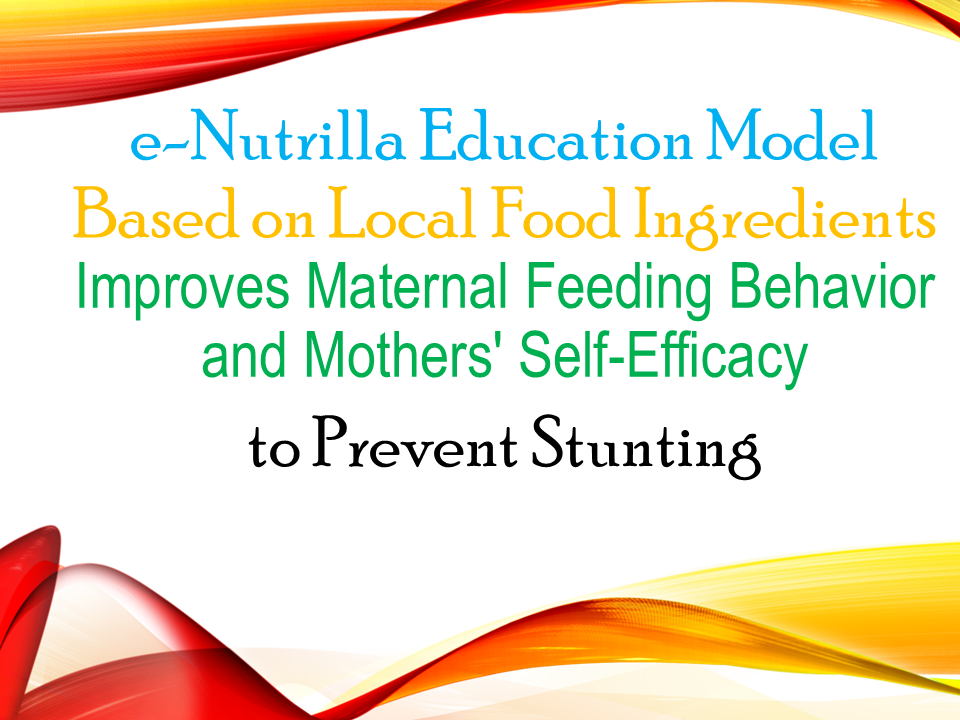eNutrilla Education Model Based on Local Food Ingredients Improves Maternal Feeding Behavior and Mothers' Self-Efficacy to Prevent Stunting
DOI:
https://doi.org/10.23917/bik.v18i1.7721Keywords:
maternal feeding behavior, stunting, local food, self efficacy, health education, enutrillaAbstract
Stunting poses a significant threat to the future Indonesia. The target of a 14% reduction in stunting has not yet been achieved. However, the 2022 Indonesian Nutrition Status Survey (SSGI) highlights the need for local food ingredients in preparing nutrition for stunting prevention. Utilizing locally available food sources serves as an alternative solution to ensure that children's nutritional needs are met easily and affordably. Education incorporating local wisdom is crucial for stunting prevention. To evaluate the effectiveness of education using the e-Nutrilla model as a method to improve children’s growth status, maternal feeding behavior, and maternal self-efficacy in providing complementary feeding (MPASI). The research design used was a one-group pretest-posttest without control. The population consisted of all mothers with children aged 12–59 months, with a sample size of 36 mothers. The statistical test applied was the Wilcoxon test. All respondents experienced an improvement in maternal feeding behavior categories from pre-test to post-test, with a Mean Rank of 18.50. The mean difference in maternal self-efficacy before and after education was 0.5, with an Asymp Sig. (2-tailed) value of 0.004. Before the intervention, 6 children (16.7%) showed no growth improvement, which decreased to 3 children (8.3%) after the intervention, with an Asymp Sig. (2-tailed) value of 0.257. The e-Nutrilla education model has a positive effect on maternal feeding behavior and maternal self-efficacy but does not significantly impact children’s growth status.
Downloads
References
Balasundaram, P. & A. I. (2023). Human Growth and Development. Treasure Island (FL): StatPearls Publishing. Available at: https://pubmed.ncbi.nlm.nih.gov/33620844/. PMID: 33620844
Beal, T., et al. (2018). ‘A review of child stunting determinants in Indonesia’, Maternal and Child Nutrition, 14(4), pp. 1–10. doi: 10.1016/j.actpsy.2022.103755 PMID: 29770565
BKKBN (2021). Policies and Strategies for Accelerating Stunting Reduction in Indonesia. Module 1. Jakarta: BKKBN.
Casnuri, L., Lestiawati, E., & Hayani, N. (2022). ‘Effectiveness of Nutritional Education in Improving Feeding Practices for Toddlers as an Effort to Prevent Stunting in Sidokerto Village, Purwomartani, Kalasan, DIY’, TSJKeb_Jurnal, 7.
Chen, T. L. & Chien, L. Y. (2022). ‘Feeding self-efficacy and feeding outcome expectancy mediate the association between maternal depressive symptoms and responsive feeding’, Acta Psychologica, 230, p. 103755. https://pubmed.ncbi.nlm.nih.gov/36179509/ 10.1016/j.actpsy.2022.103755. PMID: 36179509
Dwi, N., et al. (2023). ‘Description of Maternal Self-Efficacy in Providing MP-ASI and Stunting Incidence in Infants’, The Journal of Indonesian Community Nutrition, 12(1), pp. 27–37.
Hashmi, A., et al. (2019). ‘The Healthy Baby Flipbook: piloting home-based counseling for refugee mothers to improve infant feeding and water, sanitation, and hygiene (WASH) practices’, Global Health Action, 12(1). https://pubmed.ncbi.nlm.nih.gov/31154995/ PMCID: PMC6338267 DOI: 10.1080/16549716.2018.1560115 PMID: 31154995
Kemenkes (2022). Pocket Book: Results of the Indonesian Nutrition Status Survey (SSGI) 2022.
Kementerian Kesehatan (2021). Technical Guidelines for the Development and Implementation of Behavior Change Communication Strategies for Accelerating Stunting Prevention (Book 1), Ministry of Health of the Republic of Indonesia. Available at: https://promkes.kemkes.go.id/download/fpkk/files49505Juknis%20Implementasi%20KPP%20Stunting_ISBN_13072021.pdf.
Kementerian PPN/Bappenas (2018). ‘Guidelines for the Implementation of Integrated Stunting Reduction Interventions at the District/City Level’, National Action Plan for Stunting Reduction: Rembuk Stunting, (November), pp. 1–51. Available at: https://www.bappenas.go.id.
Manan, A. A. & Lubis, A. S. (2022). ‘The Relationship Between Maternal Behavior in Feeding Toddlers and Stunting Cases’, Jurnal Kesehatan Perintis, 21(1), pp. 134–138.
Mistry, S. K., Hossain, M. B. & Arora, A. (2019). ‘Maternal nutrition counseling is associated with reduced stunting prevalence and improved feeding practices in early childhood: A post-program comparison study’, Nutrition Journal, 18(1), pp. 1–9. https://doi.org/10.1186/s12937-019-0473-z
Wirdana, A. H. K. W. (2023). ‘The Impact of Health Education Utilizing Local Languages on Mother's Behavior in Child Feeding at the Tempe Health Center, Wajo Regency in 2022’, Maternal & Neonatal Health Journal, 4(1), pp. 12–20.
Nova, M. & Afriyanti, O. (2018). ‘The Relationship of Body Weight, Exclusive Breastfeeding, MP-ASI, and Energy Intake with Stunting in Toddlers Aged 24–59 Months in Lubuk Buaya Health Center’, Jurnal Kesehatan Perintis, 5(1), pp. 39–45. https://doi.org/10.33653/jkp.v5i1.92
Rezky, D., et al. (2023). ‘The Effect of Educational Practices of MP-ASI on Mother's Self-Efficacy in 6-24 Month-Old Children’, Jurnal Kesehatan, 18, pp. 32–38.
Sari, I. Y., Prawesti, I. & Febrianti, S. (2021). ‘E-Counseling Nutrition-Based Social Media as an Effort to Reduce Stunting Rates’, Jurnal Kebidanan dan Keperawatan Aisyiyah, 16(2), pp. 156–166.
Sutyawan, Novidiyanto, & Wicaksono, A. (2022). ‘Optimizing the Use of Safe and Nutritious Local Foods in Stunting Prevention in Ibul Village, West Bangka’, Jurnal Pengabdian Kepada Masyarakat LP2M Universitas Hassanudin, 6(3), pp. 565–577.
Wahyu, K., et al. (2021). ‘Study of Village Potential as an Improvement of the Economic Conditions in Monggol Village, Saptosari District, Gunung Kidul Regency’, Jurnal Atma Inovasia, 1(1), pp. 81–88.
Wati, K., Kartini, A. & Rahfiludin, M. Z. (2021). ‘The Influence of Assistance with Media Booklet on Maternal Behavior in Feeding Stunting Toddlers (Study in the Working Area of Karangdadap Health Center, Pekalongan Regency)’, Jurnal Aisyah: Jurnal Ilmu Kesehatan, 6(3). https://aisyah.journalpress.id/index.php/jika/article/view/6386/pdf DOI:10.30604/jika.v6i3.951

Downloads
Submitted
Accepted
Published
How to Cite
Issue
Section
License
Copyright (c) 2025 Ignasia Yunita Sari, Nining Indrawati, Mei Rianita Elfrida Sinaga, Alda Tri Erawati, Christine Ester Rumbiak

This work is licensed under a Creative Commons Attribution 4.0 International License.


















